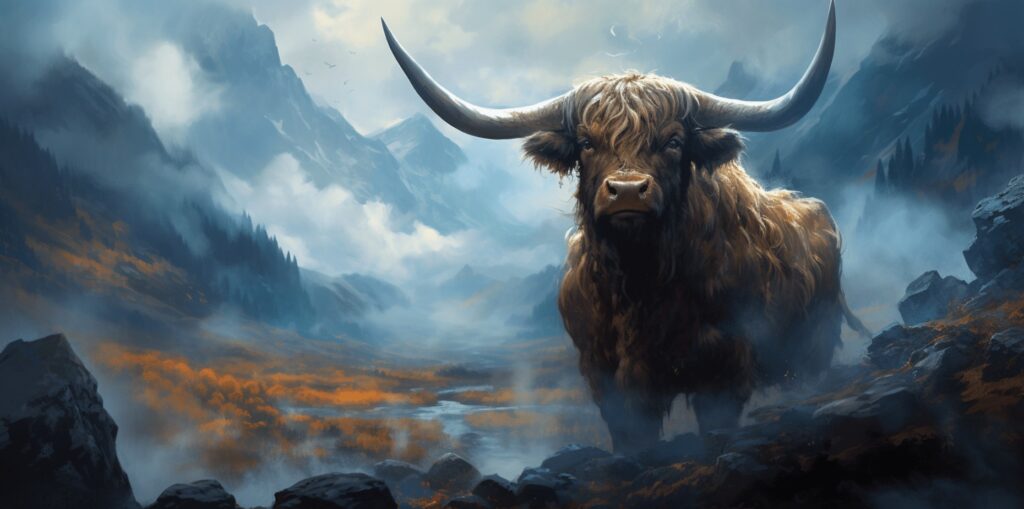Blog, Tales of the Gods
Audhumla – The Primeval Cow of Norse Mythology
In the rich tapestry of Norse mythology, where gods, giants, and mythical beings abound, there exists a lesser-known but significant figure named Audhumla. Revered for her role in the creation of the cosmos, Audhumla emerges from the primordial void of Ginnungagap, the gap between ice and fire. In this article, we embark on a journey to explore the origins, myths, and cultural significance of Audhumla – the primeval cow at the heart of Norse cosmogony.
Mythological Origins
In the beginning, before the creation of the worlds, there was Ginnungagap, a vast and formless void where ice from the realm of Niflheim and fire from the realm of Muspelheim met. Within this primordial chaos, the first being, Ymir, emerged. But Ymir’s existence was dependent on sustenance, and this is where Audhumla plays her vital role.
Described as a primeval cow, Audhumla nourished herself by licking the salty ice that surrounded her. Her actions gradually uncovered Buri, the first god and progenitor of the Aesir gods. Thus, Audhumla’s simple act of nourishment gave birth to the gods and set the stage for the creation of the cosmos.
Audhumla and the Birth of Ymir
As Audhumla continued to lick the ice, she exposed more than just Buri. Her actions also brought forth Ymir, a giant, from the ice. In a profound connection between the two beings, Ymir found nourishment from Audhumla’s milk, and she, in turn, found sustenance from the ice. This symbiotic relationship not only symbolized the interconnectedness of life but also set the course for the future conflicts between the gods and the giants in Norse mythology.
The Cosmic Tree – Yggdrasil
Audhumla’s role in the creation of Ymir was only the beginning of her significance in Norse cosmology. Through the generations, the world tree, Yggdrasil, came into being. Yggdrasil’s roots extended to the realms of Asgard, Midgard, and Niflheim, while its branches reached toward the heavens, touching the realm of the gods.
Audhumla’s actions in the primordial void laid the foundation for Yggdrasil’s existence, serving as a bridge between the worlds and fostering the interconnectedness of the Nine Worlds in Norse mythology. As the cosmic tree upheld the cosmos, Audhumla’s legacy echoed through the ages, resonating with the symbolism of life, death, and rebirth.
Audhumla in Norse Culture
In ancient Norse society, Audhumla held a significant place in the collective consciousness of the people. As a primal force of creation and fertility, she represented the life-giving essence of the cosmos. Audhumla’s connection with the sustenance of Ymir and the birth of the gods mirrored the cycle of life, and her presence likely played a role in rituals and ceremonies honoring the natural cycles of existence.
Furthermore, Audhumla’s story may have been intertwined with agricultural practices, as cows held immense value as a source of sustenance and prosperity in Norse culture. As a revered being, Audhumla would have embodied the sacredness of life and the interconnectedness between humans, animals, and the natural world.
Audhumla’s Influence in Modern Media
Despite being a lesser-known figure in Norse mythology, Audhumla’s mythical presence has left an indelible mark in modern literature, art, and popular culture. Authors and artists have drawn inspiration from her role as the primeval cow that gave birth to the gods and shaped the cosmos.
In contemporary literature, fantasy authors have incorporated Audhumla into their narratives, reimagining her origins and significance. Her story resonates with themes of creation, sacrifice, and the enduring power of life, appealing to readers seeking depth and complexity in their mythical tales.
Audhumla’s symbolic connection with the natural world has also been depicted in visual art. Painters, sculptors, and illustrators have portrayed her in various forms, capturing the essence of her role as the life-giving force that sustains the cosmos.
Moreover, Audhumla’s legacy has influenced the portrayal of cows in modern media, where they are sometimes depicted as sacred and revered beings, echoing the sacredness attributed to her in Norse mythology.
Conclusion:
As we unravel the enigmatic role of Audhumla in Norse mythology, we discover a significant and profound figure at the heart of creation. Her emergence from the primordial void, her nurturing of the first gods, and her connection to the cosmic tree, Yggdrasil, underscore her essential role in shaping the Norse cosmos.
Beyond her mythical significance, Audhumla’s legacy also reflects the cultural values of ancient Norse society, where the sacredness of life, the interconnectedness of beings, and the cycles of existence held great importance.
In the modern world, Audhumla’s presence endures through the realms of literature, art, and popular culture, where her timeless allure continues to captivate those who seek meaning and inspiration in the ancient myths of the Norse pantheon. As we embrace her enduring legacy, may we find a deeper appreciation for the interconnectedness of all life and the profound mysteries that lie at the heart of creation.

